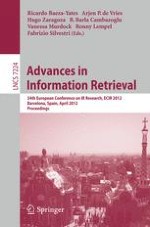2012 | Book
Advances in Information Retrieval
34th European Conference on IR Research, ECIR 2012, Barcelona, Spain, April 1-5, 2012. Proceedings
Editors: Ricardo Baeza-Yates, Arjen P. de Vries, Hugo Zaragoza, B. Barla Cambazoglu, Vanessa Murdock, Ronny Lempel, Fabrizio Silvestri
Publisher: Springer Berlin Heidelberg
Book Series : Lecture Notes in Computer Science
